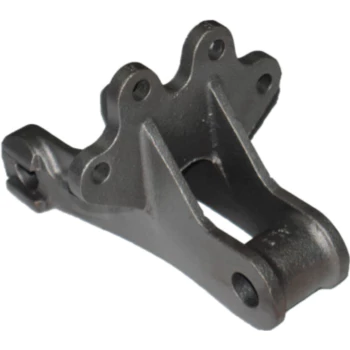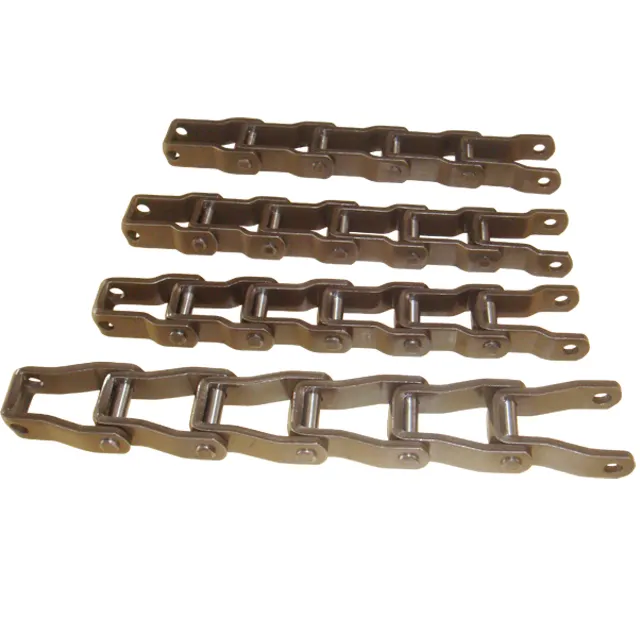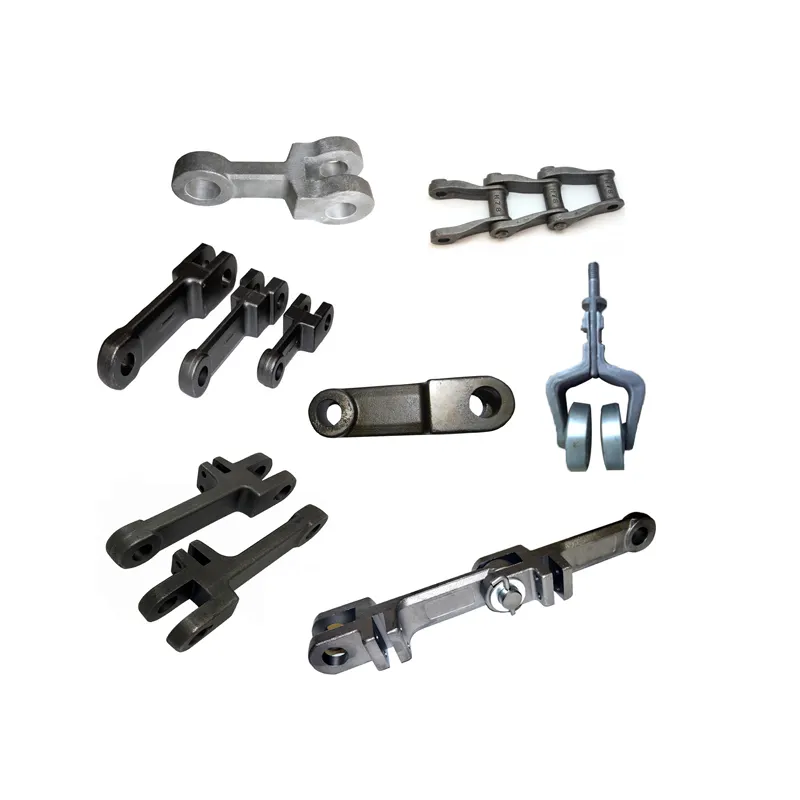Product Description
Steel pintle chain(conveyor chain) were originally developed for the agricultural implement industry. The original sizes were developed to run on the same sprockets as their detachable chain counterparts of ANSI B29.6. In later years, sizes were developed to accommodate industrial applications. Open Barrel Steel Pintle Chains are recommended as conveyor chains for a wide range of applications such as spreaders, feeder systems, hay handling equipment and spray box, and in limited use, as power transmission chains. These chains can be applied in the smudgy environment.
The items available:
1)D205
2)662
3)662H
4)667X
5)667XH
6)D667K
7)667H
8)667J
9)88K
10)D88C
CONTACT US
| Usage: | Transportation Chain |
|---|---|
| Material: | Alloy/Carbon Steel |
| Surface Treatment: | Polishing |
| Feature: | Heat Resistant |
| Chain Size: | 1/2"*3/32" |
| Structure: | Welded Chain |
| Customization: |
Available
| Customized Request |
|---|

Can pintle chains be used in agriculture and farming equipment?
Yes, pintle chains are commonly used in agriculture and farming equipment due to their strength, durability, and ability to handle heavy loads. These chains play a crucial role in various agricultural tasks, making them an essential component in farming machinery. Here are some common applications of pintle chains in agriculture and farming equipment:
1. Combine Harvesters:
Pintle chains are used in combine harvesters to efficiently convey and move harvested crops from the cutting platform to the grain tank or wagon. These chains can handle the heavy loads of crops, ensuring smooth harvesting operations.
2. Balers:
In balers, pintle chains assist in compressing and forming bales of hay, straw, or other agricultural materials. These chains help maintain the integrity of the bales during the baling process.
3. Forage Harvesters:
Pintle chains are used in forage harvesters to transport chopped forage from the cutting unit to the collection system or wagon. They provide reliable and efficient conveyance of forage materials.
4. Planters and Seeders:
In planting and seeding equipment, pintle chains are used to convey seeds or seedlings from the hopper to the planting mechanism, ensuring precise and consistent planting.
5. Grain Augers:
Pintle chains are employed in grain augers to transport grains or other materials from the intake hopper to the discharge spout. These chains can handle the bulk movement of grains efficiently.
6. Grain Elevators:
In grain elevators, pintle chains are used to lift and transport grains vertically between different levels, enabling easy and efficient grain handling.
7. Silage Choppers:
Pintle chains are used in silage choppers to transport chopped silage from the cutter head to the wagon or storage area. These chains are designed to handle the abrasive nature of silage materials.
8. Manure Spreaders:
In manure spreaders, pintle chains assist in conveying and spreading manure across fields, contributing to soil enrichment and fertilization.
Overall, pintle chains are a reliable and versatile choice for various agricultural applications. Their robust construction and ability to handle heavy loads make them suitable for use in different farming equipment, enhancing the efficiency and productivity of agricultural operations.

Can pintle chains be used in marine or underwater applications?
Yes, pintle chains can be used in marine or underwater applications, and they are well-suited for such environments due to their design and material options.
Pintle chains are known for their robust construction and ability to handle heavy loads, making them suitable for marine applications that require strength and durability. They are commonly used in marine equipment such as anchor chains, ship mooring systems, and marine propulsion systems.
The use of stainless steel in pintle chain manufacturing further enhances their suitability for marine and underwater applications. Stainless steel is highly resistant to corrosion from saltwater and other marine elements, ensuring that the chains maintain their performance and structural integrity even in harsh marine environments.
In marine applications, pintle chains may be exposed to seawater, humidity, and varying temperatures. Stainless steel pintle chains can withstand these conditions without succumbing to rust or degradation, providing reliable and efficient performance over extended periods.
Additionally, pintle chains are designed to handle side flexing, allowing them to navigate through sprockets and sheaves smoothly, which can be advantageous in certain marine applications where space is limited or complex routing is required.
Overall, pintle chains made from stainless steel are a preferred choice in marine and underwater applications due to their corrosion resistance, strength, and reliability, making them a valuable component in various marine equipment and systems.

What are the maintenance requirements for pintle chains?
Maintaining pintle chains is essential to ensure their longevity and reliable performance. Here’s a more detailed explanation of the maintenance requirements:
Regular Lubrication:
Proper and regular lubrication is critical for pintle chains to reduce friction and wear between the pins, bushings, and rollers. Use a suitable lubricant that can withstand the operating conditions and temperature. Lubricate the chain at recommended intervals or as needed based on the manufacturer’s guidelines.
Inspection:
Regularly inspect the pintle chain for signs of wear, elongation, and damage. Look for excessive pin wear, loose or damaged attachments, and chain elongation. Address any issues immediately to prevent further damage and downtime.
Cleaning:
Keep the pintle chain clean and free from debris, dirt, and contaminants. Regularly clean the chain using a suitable cleaning agent or solvent to remove any buildup that may affect chain performance and longevity.
Adjustment:
Ensure the pintle chain is properly tensioned and adjusted to the correct slack. Excessive slack can lead to premature wear, while overtightening can cause additional stress on the chain components. Follow the manufacturer’s guidelines for proper tensioning and adjustment.
Replacement of Worn Parts:
If any components of the pintle chain are excessively worn or damaged beyond their useful life, such as pins, bushings, or rollers, replace them promptly with genuine replacement parts from the manufacturer.
Environment Considerations:
Consider the operating environment of the pintle chain. In corrosive or harsh environments, stainless steel or plastic pintle chains may be more suitable to reduce maintenance requirements related to corrosion.
Regular Maintenance Schedule:
Develop a regular maintenance schedule and follow it diligently. Document maintenance activities, including lubrication, inspections, and replacements, to track the chain’s condition and performance over time.
Operator Training:
Train operators and maintenance personnel on proper pintle chain maintenance procedures to ensure they are familiar with the maintenance requirements and best practices.
Conclusion:
Pintle chains require regular maintenance, including proper lubrication, inspection, cleaning, adjustment, and replacement of worn parts. Following a well-defined maintenance schedule and adhering to manufacturer’s guidelines will help extend the chain’s service life, reduce downtime, and ensure safe and efficient operation.


editor by CX 2023-12-01